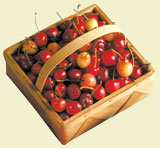Cherries from George and Apple Otte
by Jill Irwin
This article was originally published in July 2005
(July 2005) — Driving north up Highway 97 into the Okanogan Valley, it’s hard to imagine that sweet, juicy dark cherries, crisp apples and elegant Bosc pears emerge from such an arid, dramatic landscape. Massive slabs of rock scraped bare by ancient glaciers rise to meet the sky in this north-central patch of Washington.
On a slope near Tonasket, George and Apple Otte lovingly tend their orchard with careful attention to their land, their workers and their customers. “We enjoy the connection with consumers, finding homes for our fruit,” says Apple, “With a variety of fruit we can satisfy different tastes, and we like having different fruits throughout the summer to offer.”
Variety is also practical. “From a pest perspective,” she says, “it’s better to have more variety of fruit so not all your eggs are in one basket. More variety leads to more biologic and economic sustainability.”
George likes to grow organically to take care of the earth and the environment. “You can walk into an organic orchard and see living things. In a non-organic orchard, it’s a sterile environment and you don’t see any signs of life [such as birds or insects],” says George. Chemical sprays are designed to kill living things and get into the food chain.
Back in 1976, the Ottes initially came to Tonasket to pick fruit. “We wanted to get back to the land,” says Apple. They settled in the area and started raising a family, with Apple involved in the local Head Start program and George working for different orchardists on contracts.
“We always thought about having our own orchard,” they say. But after the Ottes bought their orchard in 1997, “We discovered with your own place you work twice as hard!” Apple laughs. They actually picked fruit on the orchard they now own. “This piece of land always felt blessed by the love and care the people who owned it before us put into it. They planted more variety of trees, although they did not grow organically.”
During their first year as owners, it was too late in the season to switch to organic methods and some of the pickers got rashes on their arms. The next season George and Apple started the transition to organic. “Growing organically takes more effort because it requires careful monitoring of the trees, and the timing of treatments is important,” says Apple. Following organic standards, they use some plant-derived sprays and natural fish and kelp-based fertilizers.
“The goal with organic is to have many predator insects in your orchard.” George adds, “Predator insects don’t necessarily eat all of a pest insect population (such as aphids), but they keep the pests under control.” Finding this balance is labor intensive and the Ottes use numerous strategies.

Apple points to tall grass growing at the base of a tree in their orchard and explains that the weeds are from a seed mixture they plant in the orchard that provides good predator insect habitat. “In conventional orchards, growers spray the weeds, but we cut them with a weed eater instead to maintain the habitat.” Some other ways the Ottes attack pest insects include manually snipping off aphid infestations, putting pheromone strips in the trees to confuse the pest insects so they can’t mate, and putting wadded newspaper into the trees for an earwig habitat because they eat pest insects. Apple also says they conserve water by using low-pressure misters for irrigation.
With all the labor involved in growing organically, farm workers are an essential part of the operation. “We tend to pay as much or more than most orchardists because George was employed for so long as an employee and he knows it’s hard work,” says Apple. “Also, we believe if you treat people fairly, they’ll do a good job. Working with PCC has enabled us to pay workers more so they can survive and want to come back. Workers like working on organic farms for health reasons, also.”
With a relatively small orchard such as the Ottes (18 acres in fruit), they seem more directly and personally involved than you might find at bigger farms. “There’s a lot of waste in big operations,” says Apple. “A lot of what grows doesn’t make grade due to cosmetic reasons. We try to find homes for all our fruit. The top grades go to PCC, lesser grades go to farmers’ markets, and then we make cider with the cull fruit and drink it all winter,” she explains. “For small farms to compete, we build relationships. People like fruit grown by people they know.”
At the Otte farm, they also try to spread out the cherry harvest rather than picking all at once like some bigger, conventional farms. “The Lapin cherries don’t ripen up all at the same time, so we try to pick the cherries selectively at the right time and achieve more balance,” remarks Apple.
It’s clear their orchard is a labor of love for George and Apple. As Apple stands in their orchard on a breezy spring day and spontaneously touches the trees, she says with sincerity, “My relationship to the place is one of love and appreciation. I feel thankful to the trees. We are so fortunate how the orchard has done through the care of George, but there’s good energy here. It’s sort of a two-way thing — we take care of the trees and they take care of us.”
“I see it as a whole cycle,” says Apple, “growing fruit, marketing, selling and the connection with consumers is part of the cycle. What I appreciate about PCC is its concern and care about where the food comes from — it’s all part of the cycle.”
